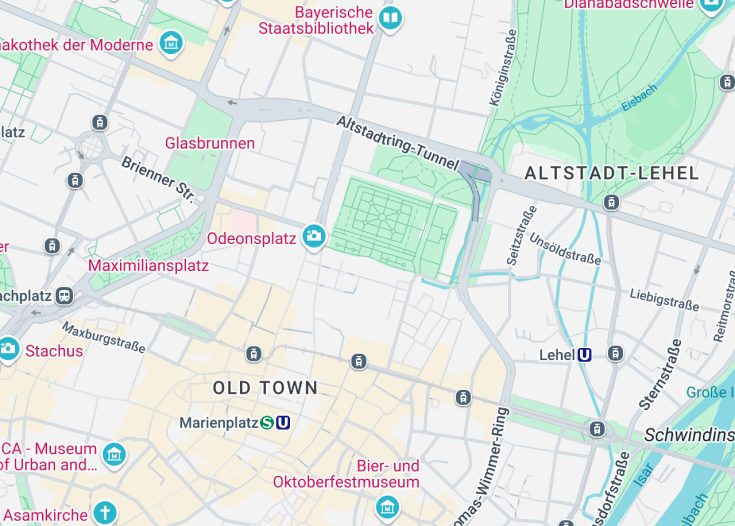The Munich Residenz, Germany’s largest city palace, has served as the seat of government and residence of the Bavarian dukes, electors, and kings from 1508 to 1918. Today, it stands as a prime museum, showcasing its rich facades and rooms that tell tales of its regal past. Visitors can explore the lavish Antiquarium, the opulent apartments, and the stunningly intricate Treasury, all steeped in history yet resonating with artistic charm. This historical edifice not only illuminates Bavarian culture but also offers a deep dive into the splendor of its royal heritage.
Plan your visit to include the Cuvilliés Theatre, an ornate Rococo masterpiece inside the Residenz, often missed but truly mesmerizing.
To fully appreciate the architectural and artistic nuances, consider joining a guided tour available in several languages.
Munich Residenz: A Royal Palace in the Heart of the City
The Munich Residenz served as the royal palace of Bavarian monarchs from 1385 to 1918. Located in central Munich, it is not only one of Germany’s largest city palaces but also a significant cultural draw. The architecture of the Residenz encapsulates the evolution from Renaissance to Baroque, Rococo, and Neoclassicism, offering visitors an extensive historical lineage preserved through opulent rooms and intricate decorations. Beyond its stunning architecture, the palace houses numerous museums including the Residenz Museum and the Treasury, which hold many of the royal family’s treasures, including ornate jewelry and various artifacts. For any visitor interested in the grandeur of past monarchies and the detailed artistry of European palaces, the Munich Residenz stands out as a must-visit. The surrounding court gardens, meticulously maintained, offer a peaceful respite from the bustling city center, adding to the overall charm and appeal of this historic site.
Exploring the Residenz Museum and Treasury
Visitors to the Munich Residenz should not miss the Residenz Museum and the Treasury. The museum spans several rooms and showcases artifacts that provide insights into the lives and reigns of Bavaria’s rulers. Among the highlights is the Antiquarium, the largest and most lavish Renaissance hall north of the Alps, adorned with historic frescoes and statues. Meanwhile, the Treasury stands out with its collection of sacred and secular treasures, including crowns, orbs, and scepters used during royal coronations. Both areas offer detailed audio tours that enrich the visitor experience, making it easier to understand the historical and cultural significance of the displayed items.
The Cuvilliés Theatre: A Baroque Masterpiece
Another gem within the Munich Residenz is the Cuvilliés Theatre, renowned for its extravagant Baroque architecture. Originally built for Elector Maximilian III, this theatre has hosted numerous prestigious opera performances throughout its history. Its intricate wooden carvings and lavish red and gold decoration make it a stunning example of Rococo design nearing theatrical perfection. The theatre witnessed the premiere of Mozart’s “Idomeneo” in 1781, establishing a long-standing tradition of significant musical performances. The preservation of this historic theatre allows visitors to step back in time and imagine the grandeur of a past era.
Discover the Munich Residenz
The Munich Residenz is a spectacular destination that caters to a wide audience, including history enthusiasts, art lovers, and architectural admirers. Whether you’re planning a family outing, a romantic excursion, or a solo adventure, this historic palace offers an enriching experience for visitors of all ages.
When you visit the Munich Residenz, you’re stepping into a world of luxurious royal apartments, stunning chapels, and incredible museums. The Residenz, once the royal palace of Bavarian monarchs, showcases ornate rooms, rich collections of antique furniture, portraits, and tapistries, preserving centuries of history under one roof.
For those interested in the arts, the Residenz houses some of the finest examples of European paintings and décor, making it a paradise for those eager to immerse themselves in classical art. In addition, the treasury of the Residenz is home to invaluable treasures that span over a millennium, promising a unique glimpse into the opulent lives of royalty.
Furthermore, the Residenz is not just about history and art. The intricate layouts of the courts and gardens provide a tranquil escape from the bustling city life, perfect for those seeking a moment of peace amidst beautiful surroundings. As you wander through the lush pathways, you’re treated to a serene atmosphere coupled with the architectural beauty of historic Bavaria.
Best times to visit the Munich Residenz
Visiting the Munich Residenz is rewarding any time of the year, but the experience can vary depending on when you go. Spring and early autumn are ideal as the weather is pleasant, and the gardens are in full bloom or beautifully golden, respectively. Summer brings longer days, although it can also mean more tourists.
If you’re looking for a special time to visit, consider the Christmas season. During this period, the Residenz hosts various festive events and decorations, making it feel even more magical.
Accessibility and limitations at the Munich Residenz
The Munich Residenz aims to be accessible to all visitors, ensuring a welcoming experience for everyone.
Accessibility
Limitations
- No pets allowed except for service animals
- Flash photography is prohibited inside the museums
Notes to visitors
- Please wear comfortable shoes as there is a significant amount of walking involved
- Be mindful of the cultural and historical significance of the exhibits
General information
Essential details to enrich your Munich Residenz experience
Location
The Munich Residenz is conveniently located near several major landmarks and is easily accessible by public transportation.
Address: Residenzstraße 1, 80333 München, Germany
Opening hours
The Munich Residenz is open daily from 9 AM to 6 PM. It is closed on certain public holidays, so checking the official website before planning your visit is advisable.
how to reach the Munich Residenz
Reaching the Munich Residenz is convenient from various locations.
Car
Parking is available nearby, and several major routes lead directly to the Residenz.
| Route | Distance | Travel time |
|---|---|---|
| From Munich Airport | 38 km | 35 minutes |
| From Munich Central Station | 2 km | 10 minutes |
| From Marienplatz | 1 km</td > | 5 minutes |
Public Transport
The Residenz is well-connected by Munich’s public transport network. Frequent trains and buses make stops nearby, ensuring a smooth travel experience from various parts of the city.
| From | Bus/Train |
|---|---|
| Munich Airport | S-Bahn S8 |
| Munich Central Station | Bus 100 |
| Marienplatz | U-Bahn U3/U6 |
Nearby Attractions
While visiting the Munich Residenz, consider exploring these attractions:
- Hofbräuhaus München – 0.5 miles (0.8 km)
- English Garden – 1.2 miles (2 km)
- Marienplatz – 0.6 miles (1 km)
- Viktualienmarkt – 0.7 miles (1.1 km)
- Deutsches Museum – 1.5 miles (2.4 km)
- Bavarian State Opera – 0.2 miles (0.3 km)
- New Town Hall – 0.5 miles (0.8 km)
- St. Peter’s Church – 0.6 miles (1 km)
- Munich Philharmonic – 1 mile (1.6 km)
- Pinakothek der Moderne – 0.9 miles (1.5 km)
- Nymphenburg Palace – 5 miles (8 km)
- Olympiapark – 3.2 miles (5.2 km)
Common questions
What are the main attractions of the Munich Residenz?
What is the historical significance of Munich Residenz?
Can you describe the architectural styles represented in the Munich Residenz?
What kind of art collections can be found in the Munich Residenz?
Are there guided tours available at Munich Residenz and what do they entail?
How can visitors best experience the gardens of the Munich Residenz?
What educational programs are available for children at the Munich Residenz?
What conservation efforts are in place for preserving the Munich Residenz?

Is the Munich Residenz worth visiting?
The Munich Residenz serves as a prime example of Germany’s rich history and the opulence of its past monarchs. As one of the largest city palaces in Europe, it boasts an impressive array of rooms decorated with rare artworks and intricate architecture that fascinates history buffs and art lovers. Moreover, the Residenz houses the exquisite Treasury, a must-see for those interested in precious jewels and goldsmith work.
However, it’s important to note that the attraction can sometimes become overcrowded, especially during peak tourist seasons, which might diminish the visiting experience. Those who prefer less crowded environments might want to explore other historical sites in Munich, like the nearby Nymphenburg Palace, which also offers beautiful insights into Bavarian royalty but in a more relaxed setting.










